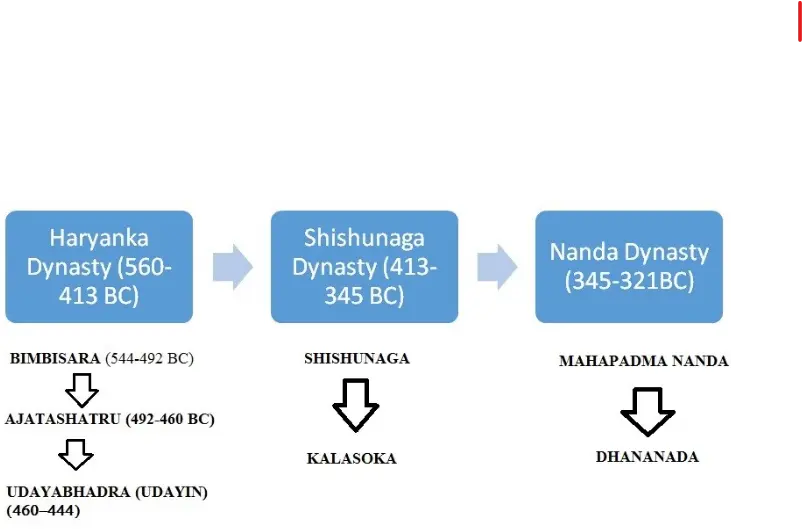Magadhan Ascendancy

- Magadha (modern day Bihar), Kosala, Vatsa, and Avanti were the most powerful among the sixteen Mahajanapadas and fought for supremacy for a century.
- Magadha, led by Bimbisara and later Ajatshatru, emerged victorious, solidifying the monarchical system in the Ganges plain.
- Bimbisara's marriage alliances aided his expansionist policy, including the conquest of Anga and parts of Kashi.
- Ajatshatru succeeded Bimbisara, defeating Prasenajit and annexing Kashi, followed by Udayin, who established Patliputra as the new capital.
- The Sisunaga dynasty succeeded the Haryanka dynasty, conquering Avanti and incorporating it into the Magadha empire, ending the long-standing rivalry.
- The Nandas succeeded the Sisunagas, annexing Kalinga, with Mahapadma Nanda being a notable king. The Nandas reportedly halted Alexander's army's advance toward Magadha before being replaced by the Mauryas.
The rise of the Magadha Kingdom (600 to 300 BC) -
|
16 Mahajanapadas |
Capital of the Mahajanapadas |
Modern Location |
Key Points about 16 Mahajanapadas |
|
1. Anga |
Champa |
Munger and Bhagalpur |
|
|
2. Magadha |
Girivraja/Rajagriha |
Gaya and Patna |
|
|
3. Kasi/Kashi |
Kasi (Banaras) |
Varanasi |
|
|
4. Vatsa |
Kaushambi |
Allahabad |
|
|
5. Kosala |
Shravasti (northern), Kushavati (southern) |
Eastern Uttar Pradesh |
|
|
6. Shurasena |
Mathura |
Western Uttar Pradesh |
|
|
7. Panchala |
Ahichchhatra (northern), and Kampilya (southern) |
Western Uttar Pradesh |
|
|
8. Kuru |
Hastinapur/ Indraprastha |
Meerut and Southeastern Haryana |
|
|
9. Matsya |
Virat Nagari |
Jaipur |
|
|
10. Chedi |
Shuktimati |
Bundelkhand region |
|
|
11. Avanti |
Ujjaini or Mahishmati |
Malwa and Madhya Pradesh |
|
|
12. Gandhara |
Taxila |
Rawalpindi |
|
|
13. Kamboja |
Poonch |
Rajouri and Hajra (Kashmir), NWFP (Pakistan) |
|
|
14. Asmaka or Assaka |
Potali/Podana |
Banks of Godavari |
|
|
15. Vajji |
Vaishali |
Bihar |
|
|
16. Malla |
Kusinara |
Deoria and Uttar Pradesh |
|
Factors - Rise of Magadha
i. Geographical factors
- Magadha's strategic location along the Gangetic valley with fertile soil and ample rainfall.
- Natural fortification by the Ganga, Son, and Champa rivers.
- Strategic positioning of Rajgir and Pataliputra.
ii. Economic factors
- Abundance of copper and iron deposits.
- Control over trade routes due to its location.
- Utilisation of a large population for agriculture, mining, city-building, and military purposes.
- Economic dominance facilitated by control over the Ganga and Champa rivers.
iii. Cultural factors
- Magadhan society embraced a blend of Aryan and non-Aryan cultures.
- Impact of Jainism and Buddhism led to philosophical and liberal advancements.
iv. Political factors
- Magadha had ambitious rulers with strong standing armies.
- Utilisation of advanced weaponry due to the availability of iron.
- Early adoption of elephants in the military.
- Establishment of a robust administrative system by major kings.
v. Religious factors
- Vedic philosophy had lost its original purity.
- The Vedic religion had become complicated, giving way to superstitions, dogmas, and rituals.
- Brahmans' dominance led to unrest in society, with Kshatriyas reacting against this supremacy.
- The introduction of a new agricultural economy in eastern India played a role.
- The Vaishyas desired to enhance their social status, given their improved economic position from the growing trade.
FAQs
1. What were the major characteristics of the Mahajanapadas?
- The Mahajanapadas were characterised by the emergence of large territorial states governed by monarchies.
- They marked a shift towards urbanisation and the development of political alliances.
- Trade and commerce flourished, and the period witnessed the rise of powerful rulers who patronised arts and sciences.
2. What was the origin of the Mahajanapadas?
- The Mahajanapadas, a collection of sixteen ancient Indian kingdoms, emerged from the tribes (janas) during the late Vedic period.
- These tribes established their own territorial communities, leading to the development of permanent settlements known as 'states' or 'janapadas.'
3. Why is studying the 16 Mahajanapadas of ancient India significant?
- The formation of the Mahajanapadas in the sixth century BC marked the emergence of distinct states. Understanding the Mahajanapadas is crucial for comprehending the political history of North India during that period.

